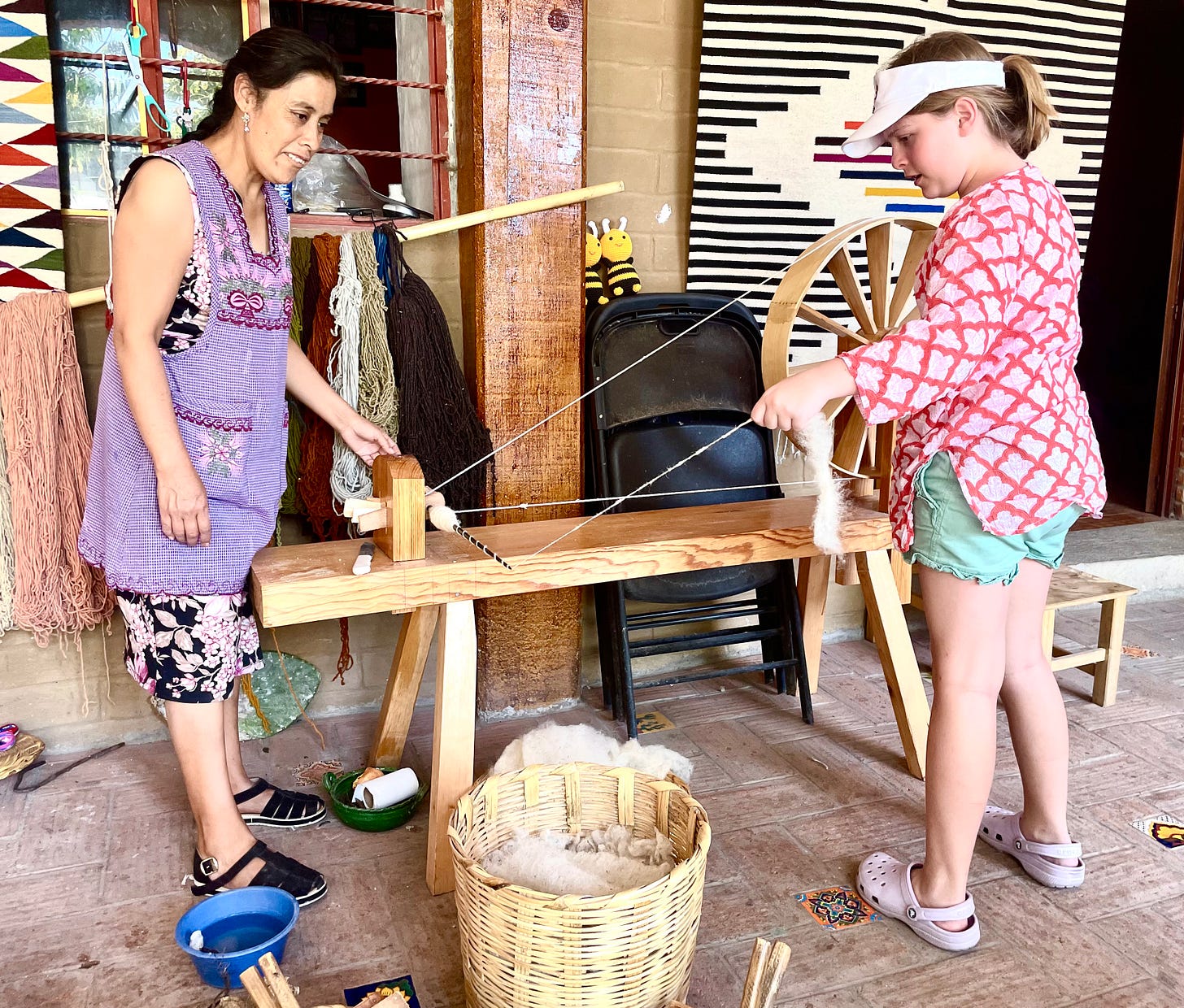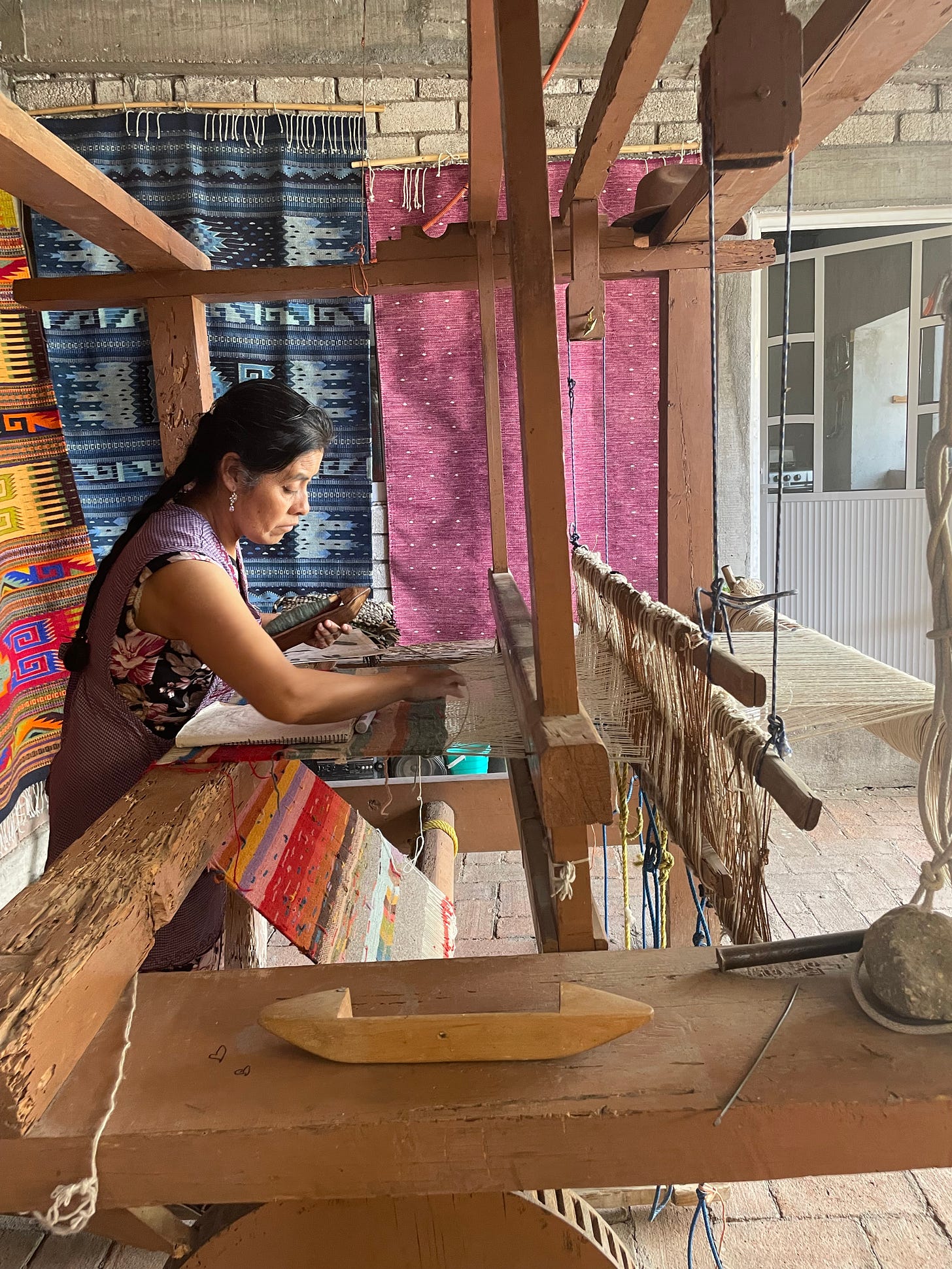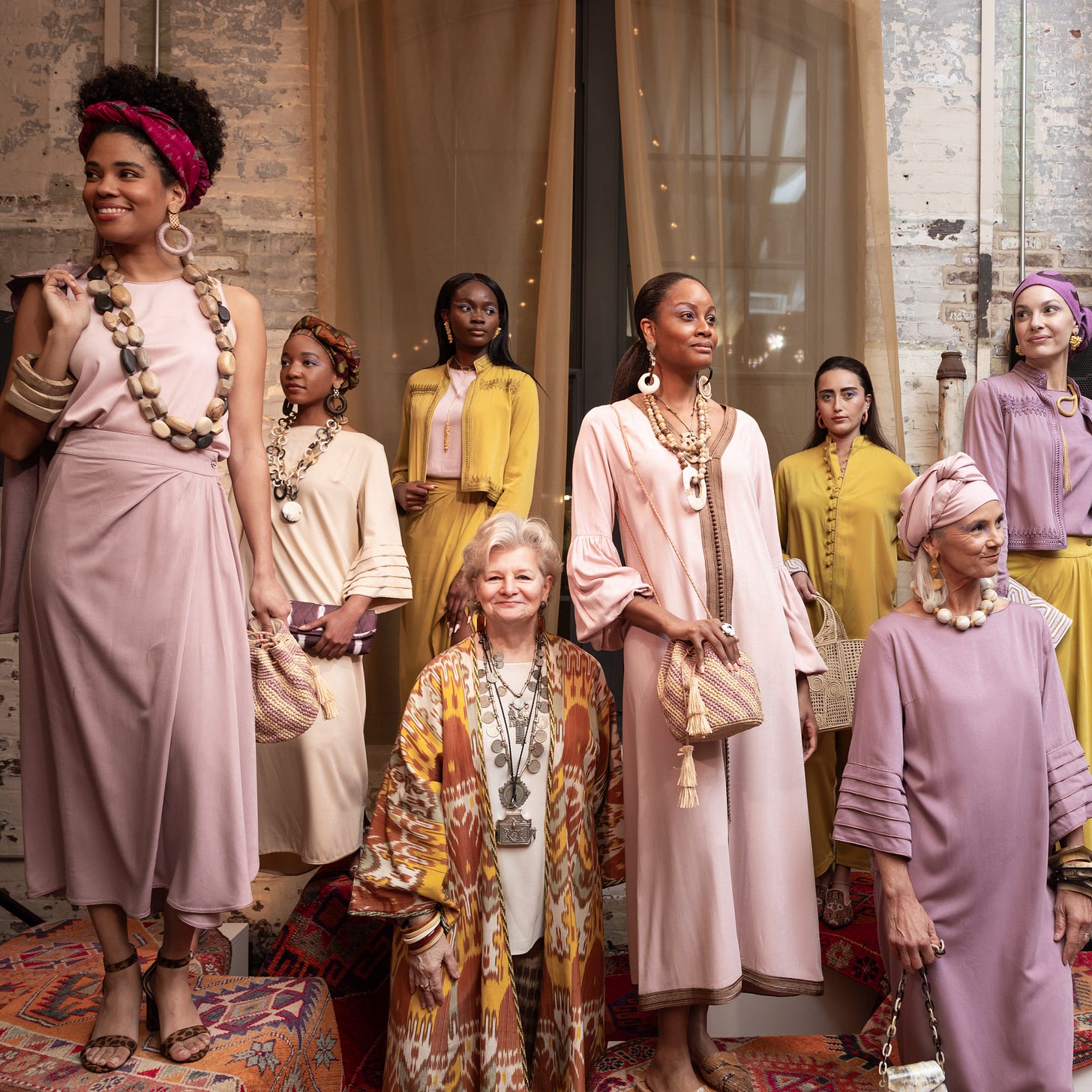Moving the needle: Weaving women power through Charleston, Oaxaca and Marrakech
Textile artisans from Mexico to Morocco are onto something curiously strong
In recent years, I have become enfolded in finely spun cloth.
Sometimes it is embroidered with swirling motifs emblematic of centuries-old cultures. Other times, it saturated in a deep shade of blue, culled from a plant grown expressly for that aim. It is patched from remnants of many clothes. It forms patterns that brightly, boldly call for change.
Like a caped crusader, women the world over are gaining power from these textiles. The one-two needle punch of a global trade market coupled with female purchasing power has converged into serious business that uplifts communities, and the women within them.
Textiles are a supple, at times surreptitious means of empowerment. Malleable, eye-catching and often woven quietly in the home, they are able to slip past entrenched modes of male dominance. They have even been known to soften the stance of repressive regimes that frown upon such female agency.
How could a few fastidious stitches—to put clothes on children’s backs, to top off the family table—work to threaten systemic gender inequity?
Charleston to Oaxaca
In Charleston of the 1700s, when British colonials were bent on making hay through cash crops like silk, a rare show of female enterprise emerged by way of Eliza Lucas Pinckney.
She tried her hand at raising silkworms—at the hands of the enslaved, to be clear. When those worms didn’t work out, she pivoted to indigo plants, hitting it big by dying fabric in the deep blue hue the plants produced.
Indigo and women were top of mind last week when I traveled with my 10-year-old daughter Beatrice to Oaxaca, Mexico. It was part of my personal mission to explore the world with her, crossing borders and generations.
Oaxaca’s renown for artisan goods, particularly textiles, was among the primary draws for our visit. With this in mind, our guide Pablo Esteban Gonzalez Marsch drove us to Teotitlan del Valle, the Zapotec village about 20 miles east of Oaxaca City that dates to the 1400s as a pre-Columbian Indigenous civilization.

We headed for the home and studio of master weaver Josefina Mendez Lopez, who furthers the family tradition creating Zapotec carpets and tapestries. Tucked beyond a modest facade with a welcoming shingle, we entered a lush central courtyard, the hub of family life. A room nearby showcased the Mendez ofrenda, or home altar, bedazzling the back wall colored lights, ornately framed family photos and tributes to Our Lady of Guadalupe.
Lopez then ushered us into her studio for weaving demonstration in the Zapotec tradition. She passed a basket fluffed with sheep wool to her mother, who expertly carded the coarse clumps between two boards that were roughly the size of pickle ball paddles and dotted with steel pins. Effortlessly smoothing the wool into a fine texture, she then twisted the wood onto a wooden spindle.

As her mother did this, Lopez detailed the organic ingredients and alchemy converging in each color, natural ingredients mixed with others to produce new shades. There were the marigolds and turmeric yielding yellow, the pecans for browns. In the palms of our hands, Beatrice and I each crushed a cochineal, an insect freed from its fix on a prickly pear cactus, marveling at the wild magenta mark it left.
And in one bowl was that true blue of a Charleston upbringing. Extracted from the leaves of the indigo plants, like those that filled Pinckney’s colonial coffers, at the Mendez home it remains a testament to the power and profit of textiles in the hands of women.
We then moved to the loom, a massive wood structure that has been in the family for a century. There, day after day, Lopez painstakingly counts off threads to match patterns, resulting in traditional Zapotec designs and modern geometries, too. It can take weeks to make a single carpet. Among the treasures I collected at the studio was a runner for my slim dining room table. A rich teal tree of life with birds of every hue perching on its leafy limbs, I envision Beatrice treasuring at her own table one day.

Marrakech in Charleston
In Charleston earlier in March, I benefitted from the broader context of legacy crafts via The Ibu Movement. For over a decade, the South Carolina-based non-profit foundation has partnered with artisans around the world to bring textiles and other sought-after goods to a global market.
Ibu partners with artisans in Mexico, as well as in Kenya, Uzbekistan, Peru, El Salvador, Turkey, Pakistan, Kyrgystan and many other communities.
On March 6, Ibu unfurled its annual Global Champions initiative at the Cedar Room in downtown Charleston. Timed with the March 8 International Women’s Day, Global Champions weaves together the global and the local, offering both an informed exchange on women’s contributions to the economy, as well as a means to power that potential further still.
With Morocco as this year’s thematic focal point, the evening fundraising event transformed the venue. Lavish, twinkle-lit honeyed swaths of cloth undulated through ceiling rafters. Below them, Marrakech delights and more were displayed in a Medina-styled market.
The crowning reveal of the evening was the new Morocco-inspired Charlotte Moss X Ibu Collection, a collaboration between the design icon and Nawal El Hariti, a Marrakech-based fashion designer.
Ibu has long identified such kindred change-makers—artists, entrepreneurs, nonprofit leaders. Some, like Moss, serve in the role of Ibu Ambassador, lending their talents and resources in many ways to Ibu’s cause.
A common thread
Earlier that morning at Charleston Library Society, a panel moderated by Carolyn Murray of WCBD News 2 gathered Moss; Marrakech cultural icon Meryanne Loum-Martin; Anne T. Weston, Ashley Hall Head of School; Kate Nevin from TSWII Capital Advisors; and Dwight L. Bush, Sr., former U.S. Ambassador to Morocco.

The connective thread was this: Now more than ever, women the world over drive commerce, community, culture, education and advancement. This was manifest in the fine details of their words, gleaned from places as diverse as small villages to corporate boardrooms.
Nevin shared financial insights, drawn from recent studies that shed light on women as collaborators, problem-solvers, innovators and leaders.
“Women by and large are closer to all the problems we face in this country—healthcare, climate change, access to education, financial inclusion,” she said. “If we’re going to have innovations, we’re going to increasingly see them coming from women.”
Weston set the bar for the future, while also referencing Ashley Hall’s past as a ground-breaking single-sex school in the South. She spoke also of the school’s ongoing efforts through Horizons, a free, all-girls program on campus to expand educational equity throughout Charleston.
“We still need single-gender education because we still don’t have gender equality, not in this country, not around the world,” she said.
Referencing his experience as U.S. Ambassador to Morocco, Bush underscored the tremendous impact of women internationally. “Any person who doesn’t appreciate the value of women is just lost,” he said.
In Morocco, he continued, women are viewed critical to the stability of the country, as agents of social entrepreneurship. Similarly, female leaders have changed the paradigm of their countries.
Loum-Martin, who owns and operates the Marrakech-based hotel Jnane Tamsna, homed in on the local, advocating for the use of products from area makers, which can result in generational wealth. With hospitality as an economic base, she aims to create family businesses to supply hospitality items including food, clothes, homeware, crafts and metalwork rather than seeing those products come into the country from industrial sources elsewhere.
“The idea is to use hospitality as platform to reach the possibilities in peoples and their families,” she said.
People weavers
When Moss was asked to name a woman who had inspired her passion and commitment to women, she credited her mother, noting the selfless way in which she managed and rallied her family. “She was the quintessential people-gatherer, along with my maternal grandmother. It’s always been important to me to do that same thing.”

At the Ibu Showroom following the discussion, Moss signed copies of “Home: A Celebration.” The magnificent, hefty book, one of 11 she has penned, was inspired by a similar effort by author Edith Wharton that gathered artistic friends to donate works as a means to philanthropy.
Moss told me that her engagement with Ibu was sprung from her encounter with founder Susan Hull Walker. When Moss once visited Charleston to speak at the Gibbes Museum of Art, she was introduced to Walker, and became quickly enthralled by her cause.
“She’s this point of connection. I just felt her commitment when I first met her. This is the thing that touches people, but then you understand the mission and you’re more committed to it.”
Crafting a future
At the evening event, after the Moroccan market and morsels, Walker took the stage.
Beaming warmly to the crowd, she introduced this year’s Global Champions: Moss, Loum-Martin; El Hariti; and Wafae Safar, a member of Cherry Buttons cooperative in Sefrou, Morocco.
“Crafting a future, that’s why we’re here tonight. And I hope there is as much joy in that future as there is here in the room tonight.
The goal was to provide opportunities for 525 artisans around the world seeking honorable work and a living wage. The evening’s auctioneer, Doug Warner, then propelled the bidding with impressive clip, while screens flashed images of Ibu’s designated recipients, who greeted guests from afar. Paddles popped up and bidders were each acknowledged with a red fez. A sea of them soon dotted the buzzing room.
The Charlotte Moss X Ibu Collection then came to vivid life as a host of models and Ibu allies glided down aisles draped in the designs—a soft parade of designs informed by Moroccan sand, fresh Palm fronds, lilacs.
From the stage, Moss reflected, “In a world that is constantly changing, and so rapidly sometimes it leaves us breathless, we’re constantly reminded of the need to slow down… and the reason why we need to sustain and maintain these legacy crafts.”
By the evening’s end, the goal of $150,000 raised. On March 8, that number grew larger still. Barry Friedberg and Charlotte Moss Family Foundation pledged to match all contributions to Ibu Movement Foundation up to $50,000 in support of artisan workshops run by women worldwide, raising $112,000 additional dollars.
It is, to be sure, a story sprung from family spindles and teased through the eyes of so many needles. And from my first-toe forays into the far-reaching world of textiles, it is one as durable as it is exquisite, woven together by women celebrating local traditions, spanning countries and generations—and poised to empower all women, one deft, intentional stitch at a time.





Reminds me of former Charlestonian Leigh Alexander, a fabulous textile artist and weaver who moved to rural New Mexico, and I believe also led an organization helping local women sustain heritage weaving.
Maura,
thank you for enlightening and educating us. Before IBU, I remember when Susan began her journey with textiles and introduced several of us to beautiful works from Afghanistan (and Pakistan?). I treasure the pieces i acquired that evening. How lucky is Beatrice to have you opening her eyes to the world through travel and new experiences!
I’m a faithful reader and greatly admire your work. Be well.